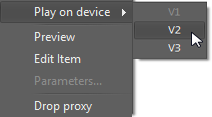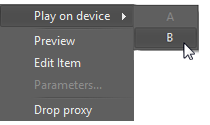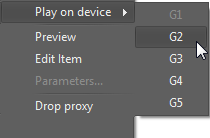Devices Controls
Reading time ~7 minutes
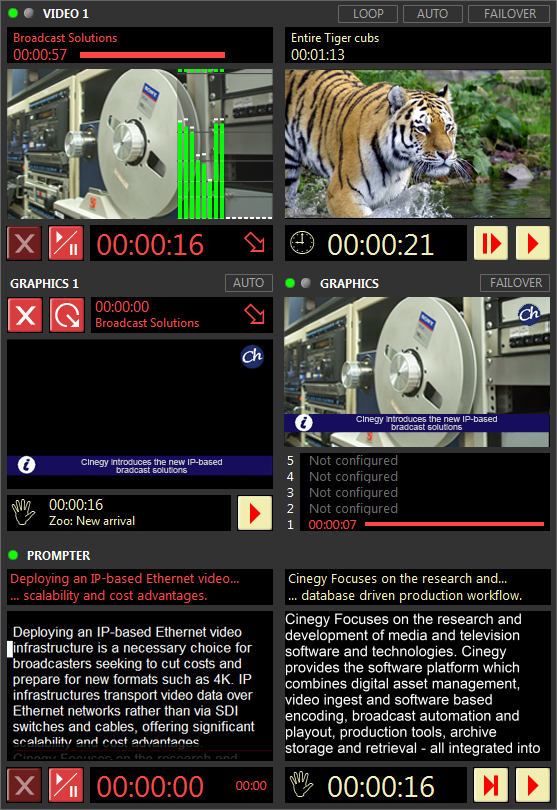
The devices controls are used to control the cued items of different types individually. There are separate panels for each device type, displaying the video, Cinegy Title template, and presenter text of the cued items.
On top of each device panel there are indicators of the device status. One indicator shows the status of the master video and CG servers, the other one indicates the status of the slave servers.
|
Note
|
The Prompter device panel contains one indicator; the Prompter server can work only in master mode. |
|
Important
|
Refer to the Devices Settings Tab article to learn more about devices configuration. |
|
When the device is set up to work as the master, the first indicator is green. If the slave device is configured, the second indicator is yellow. In case of the master device failure, the slave device automatically starts working as the master and its indicator becomes green. |
|
A red indicator warns the operator when problems with the connected device occur (for example, the connection loss). |
|
If the device is not configured, the indicator is gray. |
To simultaneously connect to all the devices configured and visible on the Cinegy Studio control panel layout, use the "Connect All" command from the "Playout" main menu:
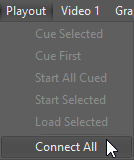
Double-clicking the "On-Air" monitor of any device will highlight the last launched item of the corresponding type on the Rundown panel. Double-clicking the "Preview" monitor will highlight the cued item of the corresponding type.
The following buttons are available on top of the devices panels:
|
The "Loop" button continuously runs the entire playlist of the corresponding video device, respectively to the start trigger of every specific playlist item. |
||
|
The "Auto" button automatically sets auto trigger to all items assigned to the corresponding devices.
|
||
|
If you are using master and slave servers, your rundown will be playing into two playout servers at the same time.If the master playout server is disconnected, broadcasting will automatically be switched over to the slave playout server. If one of them fails and then becomes available again, Cinegy Studio does not connect to it automatically; to restore the connection manually, press the "Failover" button. |
|
Important
|
When the "Autoconnect on start" option is disabled in the Cinegy Studio Configurator, this function is unavailable on Cinegy Studio start. Refer to the General Settings Tab article for details on how to set autoconnection at Cinegy Studio start. |
It is possible to assign video and graphics items to a specific video device or graphics layer via drag-and-drop to the corresponding device panel. Alternatively, use the corresponding item’s context menu:
|
|
Assigning Video Device |
Assigning Graphics Device |
|
Note
|
The primary playlist allows assigning items to devices only in Standalone mode. |
|
Tip
|
The similar action can be performed by selecting the required playlist element and using the corresponding command from the "Item" main menu. |
Video Device
The video device control can be performed in two display modes: normal and compact. In layout editing mode, select the proper context menu command to apply corresponding display mode:
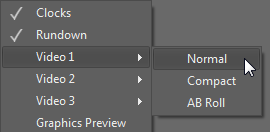
The normal device display view includes detailed information and two monitors, while the compact view displays short information and is useful for saving the layout space.
|
Note
|
The video device description further in this article represents the device panel in normal view mode. |
The video device panel consists of two parts:
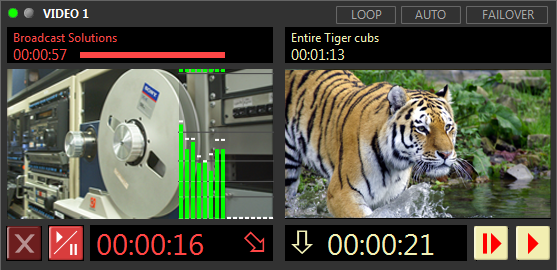
The left part contains the "On-Air" monitor, which displays the first frame of the loaded item and the playback of the item sent on air. Next to this monitor there is also an audio level indicator that shows the audio volume level of the on-air video. The audio level meter display can be disabled via the "Preferences" dialog.
The top field displays the name of the clip or Sequence currently being played, as well as its time and progress bar. The bottom field contains the time countdown and the icon of the item end trigger type.
The right part of the panel contains the "Preview" monitor, which displays the first frame of the cued video item. The top field displays the cued Sequence or clip name and its duration. The bottom field shows the time left until the cued Sequence or clip (by default) and its start trigger type icon. The default timer of the cued item can be modified via the "Preferences" dialog.
Each configured video device (up to 3) creates a separate window that controls one or two (Master and Slave) playout engines.
|
Important
|
Refer to the Cinegy Studio Playout section for details on operating the device controls. |
The progress bar above the "On-Air" monitor allows you to navigate to any desired clip position. You can view any frame of the material by dragging the slider or by clicking any position on the progress bar. These actions are only applicable for paused or loaded item.
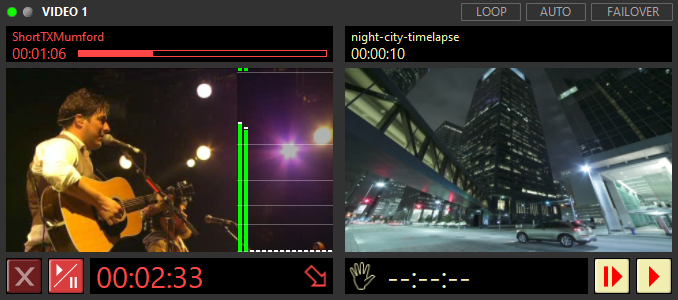
Video AB Roll
Cinegy Studio supports using the video device in AB mode, when the item can be played either on server 1 or server 2.
|
Important
|
Refer to the Devices Settings Tab article for details on devices configuration. |
Use the "AB Roll" submenu command from the "Video 1" context menu in layout editing mode to enable the device display on the layout:

The video AB device control consists of two parts; each corresponds to a configured server:
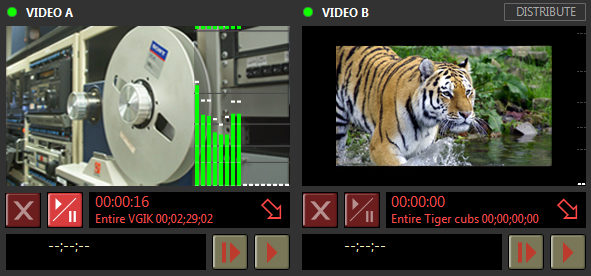
The video A and B devices playing the selected item can be switched by using the corresponding context menu commands as described earlier in this section. Alternatively, drag-and-drop the item to the corresponding part of the device panel.
|
Press the "Distribute" button to organize the clips playback so that all the odd ordered clips are sent to device A, and the even ones are sent to device B. |
Alternatively, the same command can be performed from the "Video AB" main menu.
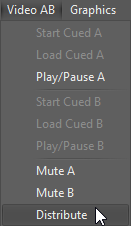
If either device connection fails, all video items are automatically sent to the connected one.
Graphics Device
It is possible to display up to five graphics layer panels as well as the graphics preview panel, using the respective commands from the layout editing mode context menu:
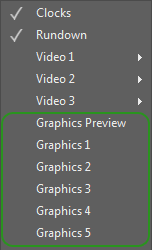
The graphics preview panel is represented by an "On-Air" monitor, which displays engine output. The field below contains graphics layers information:

Information on the configured graphics layers includes their number, the time of the item being played and the progress bar. The "Not configured" sign indicates that the layer has not been enabled in the Cinegy Studio Configuration tool.
A separate panel is dedicated to each graphics layer. The top field contains the "Hide" and "Exit loop" buttons, as well as the name of the Cinegy Title template being played, its countdown and the end trigger type icon. The preview window shows the middle frame of the loaded Cinegy Title template. The graphics display in the preview window is regulated by the "Use first frame for Graphics preview" option in the Preferences dialog.
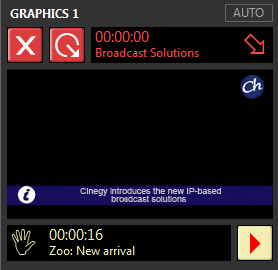
The bottom field contains the "Play" button as well as the cued template name, the countdown until its start (by default) and its start trigger type icon. The default timer of the cued item can be changed via the Preferences dialog.
|
Important
|
Refer to the Sending Stories on Air article for details on operating the device controls. |
Prompter Device
The Prompter device control can be performed in two display modes: normal and compact. Use the proper command from the context menu of layout editing mode to select desired device mode:
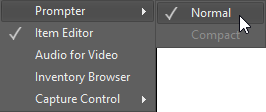
Normal device display view includes detailed information and two monitors, while compact view displays short information and is convenient to be used for the purpose of saving the layout space.
|
Note
|
The prompter device will be represented in normal view further in the manual. |
Prompter device panel consists of two parts:
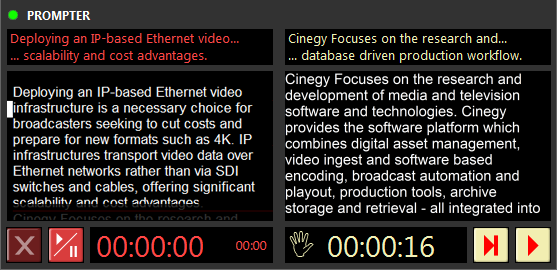
The left part contains the "On-Air" monitor, which displays the scrolling presenter text. In the top field the beginning and the end of the currently played presenter text is displayed. The bottom field contains the "Play/Pause" button, two timers and the "Exit" button.
The left timer displays the countdown for the currently played item. The timer on the right displays the variance between the scheduled and the actual script end time. A zero value indicates synchronism between the scrolling speed and reading rate, defined for the given presenter in Story Editor inside Cinegy Desktop. If the scrolling speed is changed during playback, the timer displays the variance time in the minutes:seconds format with the minus sign in case if the speed has been decreased and the plus sign if it has been increased.
The right part contains the "Preview" screen, the start trigger type icon and countdown of time left until the next cued item start (by default), as well as the "Play" and "Find cued" buttons. The default timer of the cued item can be changed via the "Preferences" dialog.
|
Important
|
The Cinegy Prompter engine displays the above-described timers as well. |
|
Important
|
Refer to the Cinegy Studio Playout section for details on operating the device controls. |






